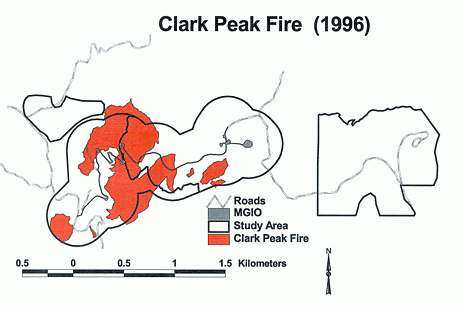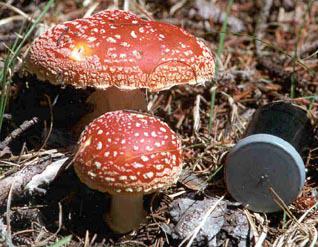MGRS Data
Population Trends of the Mount Graham Red Squirrel
The Mount Graham Red Squirrel Monitoring Program (RSMP) conducts a quarterly census of the squirrel population within their monitored areas (all areas within 300m of the Mount Graham International Observatory and Access road; and two non-construction, control areas). Biologists visit each midden site, examine it for evidence of red squirrel activity, and observe for extended periods of time to determine the presence of a resident squirrel. Multiple visits are often made to midden sites to verify the residency of a squirrel, and attempt to determine its sex, age, and any natural marks or tags.
Throughout the course of this study slight differences in red squirrel numbers between the construction and non-construction study areas have been observed. However, many natural disturbances such as fire, insect outbreaks, and fluctuations of food resources have caused significant declines in population size of these monitored squirrels. Additional research is, therefore, needed to isolate these factors in order to determine what impacts telescope construction and operation may have on the squirrel population.
The following figure depicts mountain-wide red squirrel population estimates and disturbance events through time. These population estimates are the result of inter-agency censuses conducted by Arizona Game and Fish Department in conjunction with the U. S. Fish and Wildlife Service, the U. S. Forest Service and The University of Arizona. Mountain-wide population estimates are obtained from press releases that follow interagency censuses.
MGRS_Population_timeline_1986_2019.gif
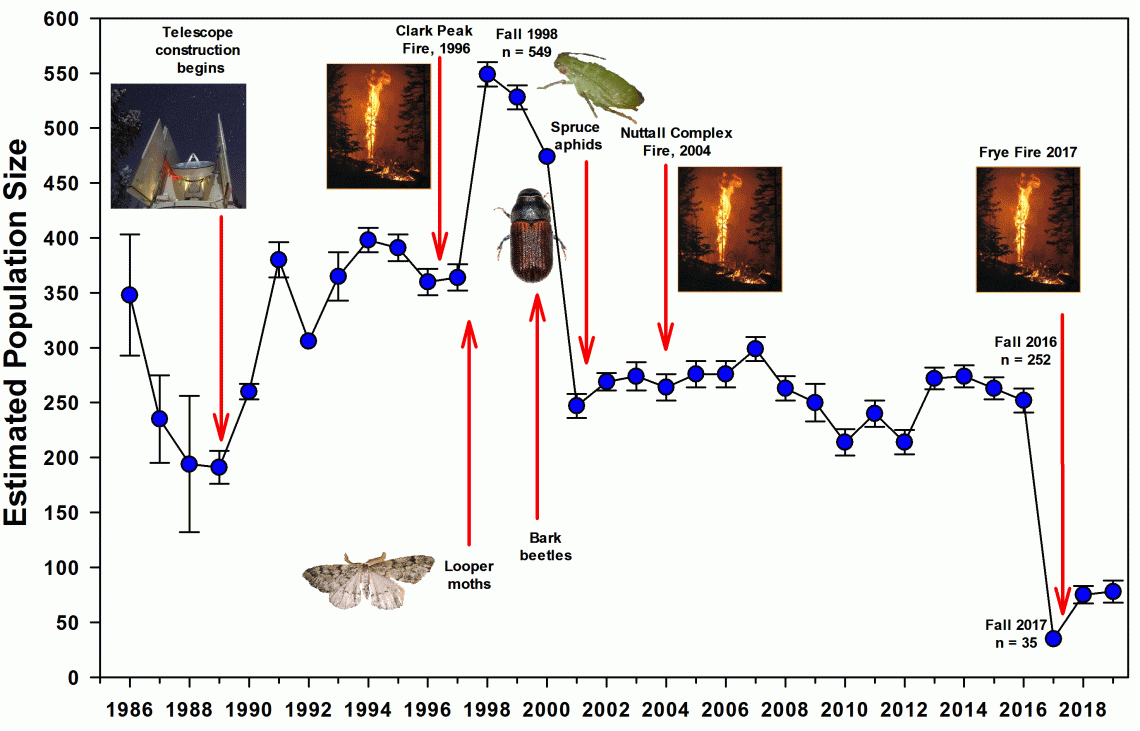
The following graph represents data collected in the RSMP monitored areas only.
AR19Figure5_PopulationEstimates.gif
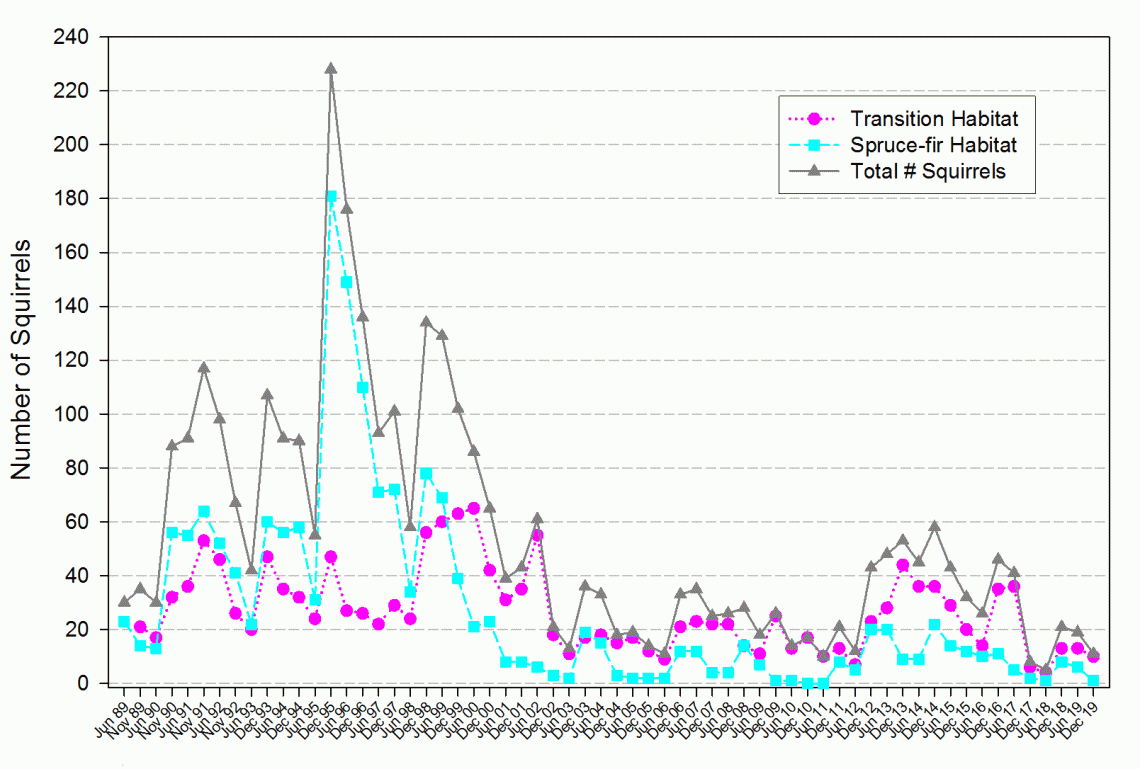
Raw Data:
Insect Outbreaks
Freezing and drought conditions in the southwest in recent years have set the stage for a series of forest insect outbreaks in the upper elevations of the Pinaleño Mountains on Mount Graham Red Squirrel Monitoring Program (RSMP) study areas. Since 1992, a cascade of disturbances has taken place leading to the current conditions in the spruce-fir habitat (SF), most noticeably large areas of standing dead/dying Engelmann spruce trees. In 1992, blowdown resulting from an ice storm provided dead timber habitat for increasing bark beetle populations. In 1996-1998, an obscure geometrid moth (Nepytia janetae) defoliated spruce and corkbark fir trees in the areas surrounding Hawk and High Peaks, and Emerald Cienega. By 1998, several highly destructive species of bark beetles had increased in spruce and fir trees likely weakened by the moth. Engelmann spruce trees on High, Hawk and Emerald Peaks have been affected by an introduced spruce aphid (Elatobium abietinum), which was detected for the first time in the Pinaleños late in 1999. In March 2000 trees as low as 2900 m elev. in transitional mixed conifer forest on RSMP study areas were seen covered with aphids.
These outbreaks are of concern to the red squirrel because habitat is directly affected by reduced cone production in physiologically stressed trees, and by increased tree mortality (see photos below). Engelmann spruce has been particularly hard-hit. At this time, Douglas-fir and white pine seem to be relatively unaffected. Occupancy of red squirrel middens in these areas has decreased since the outbreaks began. The total number of squirrels in the SF habitat has decreased from 72 in December 1997 to 8 in December of 2001. The north slope of high elevation SF habitat, where the insect activity has been the greatest, has shown the largest decrease. In December 1997, there were 23 middens occupied in this area, and by December 2001, only 1 midden remained occupied. Similar decreases in occupancy are happening at lower elevations of the SF habitat where insect activity has occurred in areas around Highwater cienega and the ridge running west from Emerald Peak.
For more information regarding insect outbreaks in the southwestern United States please visit the US Forest Service, Forest Health website
MG_HighPeak_Taken1989_JLKcrop.jpg

MG_HighPeak_TakenSep07crop.jpg
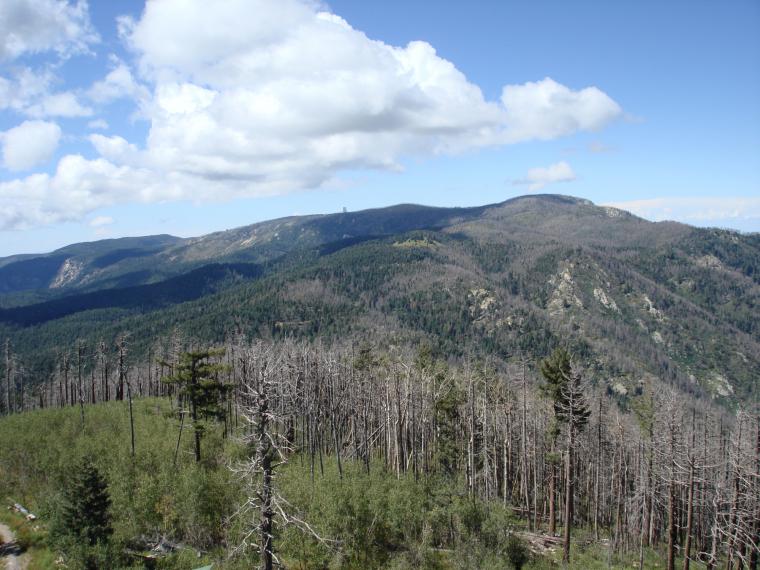
Janet's false hemlock looper (Nepytia janetae)
looper.jpg
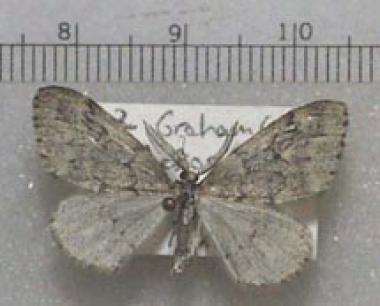
This largely unknown moth was first described in 1966 and is endemic to the White and Pinaleño Mountain ranges of AZ, and the Capitan and Sacramento Mountains of NM. The moth outbreak was checked by natural disease and parasites. Some larvae turned red and died as a result of an unknown pathogen. Many larvae were killed by parasitoids including a tachinid fly, Madremyia saundersii (identification by Jim O'Hara, Agriculture and Agri-Food Canada), and two unidentified ichneumonid wasps. Photo by: Bruce Walsh
Spruce aphid (Elatobium abietinum)
spruce-aphid.jpg
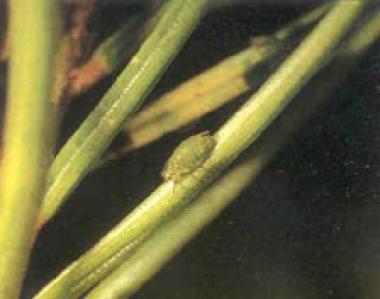
The spruce aphid attacks Picea spp. in the Pacific Northwest, Canada, Europe and other parts of the world. It is highly destructive to Engelmann spruce in the southwestern United States. This species was first reported in Arizona in 1988 in the White Mountains, and in the Pinaleño Mountains in 1999 by Ann Lynch of the USFS Rocky Mt. Research Station. Populations may be limited by freezing weather, and it is unknown whether there are naturally occurring disease or predator checks. In the fall of 1999, RSMP personnel observed Mt. Graham red squirrels feeding on spruce aphids by gleaning them from branch tips. During the March 2000 census, many Engelmann spruce trees at lower elevations were also seen with heavy infestations of aphids
Spruce Beetle (Dendroctonus rufipennis) and
Western balsam bark beetle (Drycoetes confusus)
spruce-beetle.jpg

The spruce beetle is the most significant natural mortality agent of mature spruce. It infests all Picea spp. within its geographic range. Outbreaks usually last 2-5 years and result in a depletion of large diameter spruce trees within the forest. Natural controls include cold winter temperatures as well as cold, wet weather during flight periods. The primary host of the western balsam bark beetle is subalpine fir (Abies lasiocarpa). Its range generally overlaps that of the alpine fir. These species were first recorded in the Pinaleño Mountains in 1998 in areas of N. janetae defoliation. An approximate total of 730 acres of mature spruce and fir trees in the upper elevations has already been killed and an estimated additional 700 acres, in several lower elevation mixed conifer stands, have been affected. Bark beetle infested trees generally tend to die and fall within three years.
Wildfires Within Red Squirrel Habitat
Three major wildfires have damaged critical red squirrel habitat within the red squirrel refugium on Mt. Graham. The human-caused Clark Peak Fire began in 1996 and damaged 2600 hectares and the Nuttall Fire complex was a merging of two lightning-caused fires in 2004 that damaged 12,029 hectares, and the Frye Fire was a lighting-caused fire in 2017 that damaged 19,604 hectares.
Clark Peak Fire
The Clark Peak fire was a human-caused fire that started on April 24, 1996 in the Riggs Lake area at the northwest end of the mountain range. The fire was contained at about 6500 acres (2600 ha) by May 9. Several areas within the burn were known to contain midden sites of the endangered Mt. Graham red squirrel. Within the RSMP study area, 24.5 hectares of spruce-fir habitat was burned (a 23% reduction from the original 205 hectares), and 34 hectares of mixed conifer transitional habitat was burned (a 32% reduction from the original 106 hectares).
Although the fire encompassed over 2600 ha, not all of the forest within that area was totally destroyed. Some of the red squirrel middens within the burned area were completely destroyed, but others escaped without any damage. The USDA-Forest Service estimates that about 50 percent of the middens within the burned area were destroyed, but the remaining middens were still suitable for red squirrel habitation.
Most of the burn on the University of Arizona monitored areas (approximately 34 ha in the mixed-conifer habitat and 24.5 ha in the spruce-fir habitat) was very intense and completely destroyed the forest. Thirty-three midden sites were destroyed and several more damaged by less intense ground fires. Twenty-three of the destroyed middens had been occupied by red squirrels before the fire began. After the fire, only one destroyed midden, which was close to an unburned area, continued to be occupied for the next 2 months. Another midden was occupied until mid-June.
Below is a map depicting damage to the RSMP study areas by the Clark Peak Fire.
Nuttal Fire Complex
The Nuttall Fire Complex began as two lightning-caused fires on 22 June 2004 (Gibson Fire) and 26 June 2004 (Nuttall Fire) and the two fires merged on 2 July 2004. The fire perimeter covered most of the northeast half of the Pinaleño range at elevations from 1,371 m to the highest point in the range, Mt. Graham at 3,267 m. The fires were contained after 19 July 2004, and the USFS Burned Area Response Team (BAER) estimated the total fire size at 12,029 hectares. Of this area, 6,354 hectares were categorized as low to unburned burn severity, 4,593 hectares at moderate severity, and 1,083 hectares at high severity. Within the RSMP study area, 88 hectares of spruce-fir habitat was burned (a 43% reduction from the original 205 hectares). For more information and photos, visit the Southwest Area Incident Management Team's website or the Large Binocular Telescope Observatory's website.
As with the Clark Peak fire, not all of the middens within the burn perimeter were totally destroyed. Whereas the Clark Peak fire damaged more middens in the mixed conifer transitional habitat, the Nuttall Fire Complex hit the spruce-fir habitat the hardest. During the 2004 census of middens within the RSMP study area, each midden was visited and assessed for damage to the substrate, vegetation, and canopy layers within a 10 m radius of the cone scale pile. Prior to the Nuttall Fire, there were 388 known middens within and just outside of the RSMP study areas. Of these, 114 or nearly 30% were severely burned, the majority of these middens (90%) were in the higher-elevation spruce-fir habitat. Twenty five middens were lightly or moderately burned (6% of total), and all of these middens were located in the spruce-fir habitat. In addition, 15 middens (4% of total) were damaged by fire suppression efforts - almost all of these (14) were in spruce-fir habitat.
Twenty radio-collared squirrels were directly affected by the Nuttall complex fire, occupying 20 middens within the burn perimeter. Of these 20 middens, 15 were severely burned and 35% of the collared squirrels occupying these middens did not survive the fire (Koprowski et al. 2006). Currently, research is underway to determine to what degree red squirrels utilize these burned areas.
Below is a map of the Clark Peak and Nuttall Fire Complex burn perimeters in relation to RSMP study areas and the red squirrel refugium (areas above 10,000 ft) on Mt. Graham.
Frye Fire
The Frye Fire began on 7 June 2017 from a lightning strike in the old burn scar of the 2004 Nuttall Complex Fire. As of 20 July 2017, the fire perimeter is 19,604 hectares at 98% containment. The Frye Fire ranged in elevation from 1,219 to above 3,000 m, and impacted the remaining spruce-fir forest as well as much of the mixed-conifer forest where the majority of the red squirrel population currently inhabits. Preliminary assessments of burn severity from the Burned Area Emergency Response Team (BAER) estimates that 776 hectares are classified as "High" burn severity, 2,152 hectares classified as "Moderate" burn severity, and 12,726 hectares classified as "Low" severity. These ratings are based upon soil burn severity.
Stay tuned for more information as we assess how the Frye Fire has affected red squirrels and associated territory occupancy within RSMP study areas as well as mountain-wide.
Frye Fire mountain-wide burn severity map
FryeFireBurnSeverityandAffectedMiddens.jpg
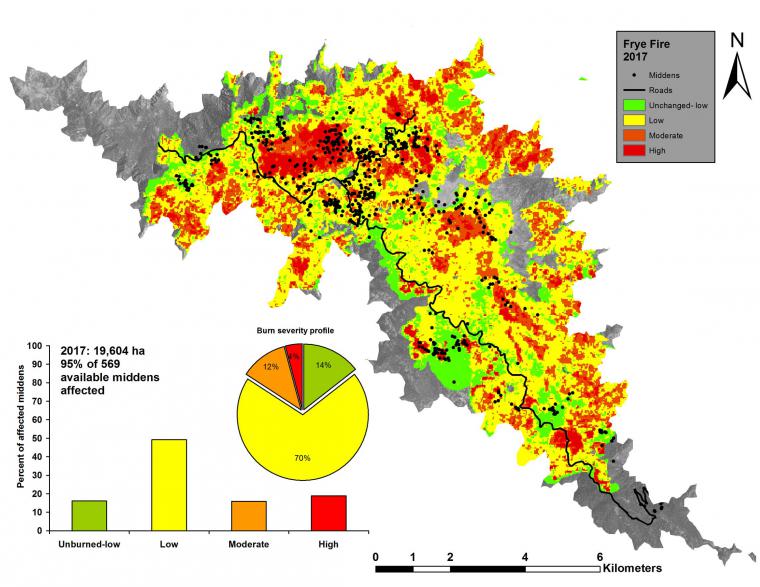
MG_SpruceFirRemnantViewFromPlaneMJM.jpg
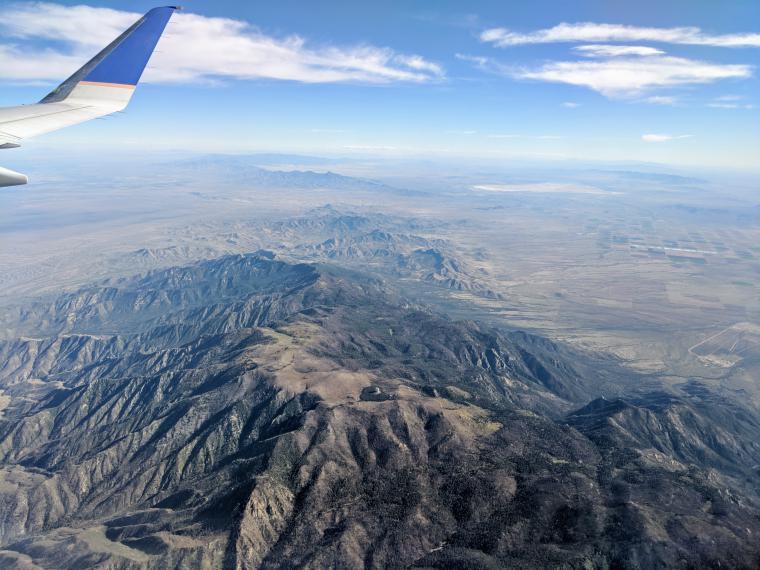
Food Resource Availability
As part of our long-term monitoring efforts we, The Mount Graham Red Squirrel Monitoring Program, have conducted conifer seed availability and mushroom availability studies since the early 1990's
Conifer-Seeds
A series of seed traps were set out at randomly placed plots in July 1993, and seeds have been collected and identified each spring (following snow-melt) to determine total seed fall for a year. The number of seeds/m2 for each species is determined for each trap, the average seed fall for each plot is extrapolated to seeds/ha. Seed fall has been measured since the 1993 cone crop and has allowed us to quantify the good spruce crops of 1993 and 1995. The seeds of white pine and ponderosa pine are not readily dispersed by wind due to their large size. Because of this, the crops of these species are underrepresented in the seed trap samples. Both of these species may be important local food supplies for red squirrels, but at present, there is no reliable method for estimating the size of the crops. This project will continue through at least one more major spruce crop in order to better understand the size of the crops and their periodicity.
Our research areas are divided into four main regions based upon the initial monitoring needs when the red squirrel research program was established:
TRC: mixed-conifer transition forest within 300 meters of road and telescope construction activity
TRN: mixed-conifer transition forest >300 meters from road and telescope construction activity
SFC: spruce-fir forest within 300 meters of road and telescope construction activity
SFN: spruce-fir forest >300 meters from road and telescope construction activity
Filled seeds: conifer seeds where potentially viable endosperm was encountered, as determined by oily residue left behind following compression (i.e. "squishing").
AR19EngelmannSpruceSeeds.gif
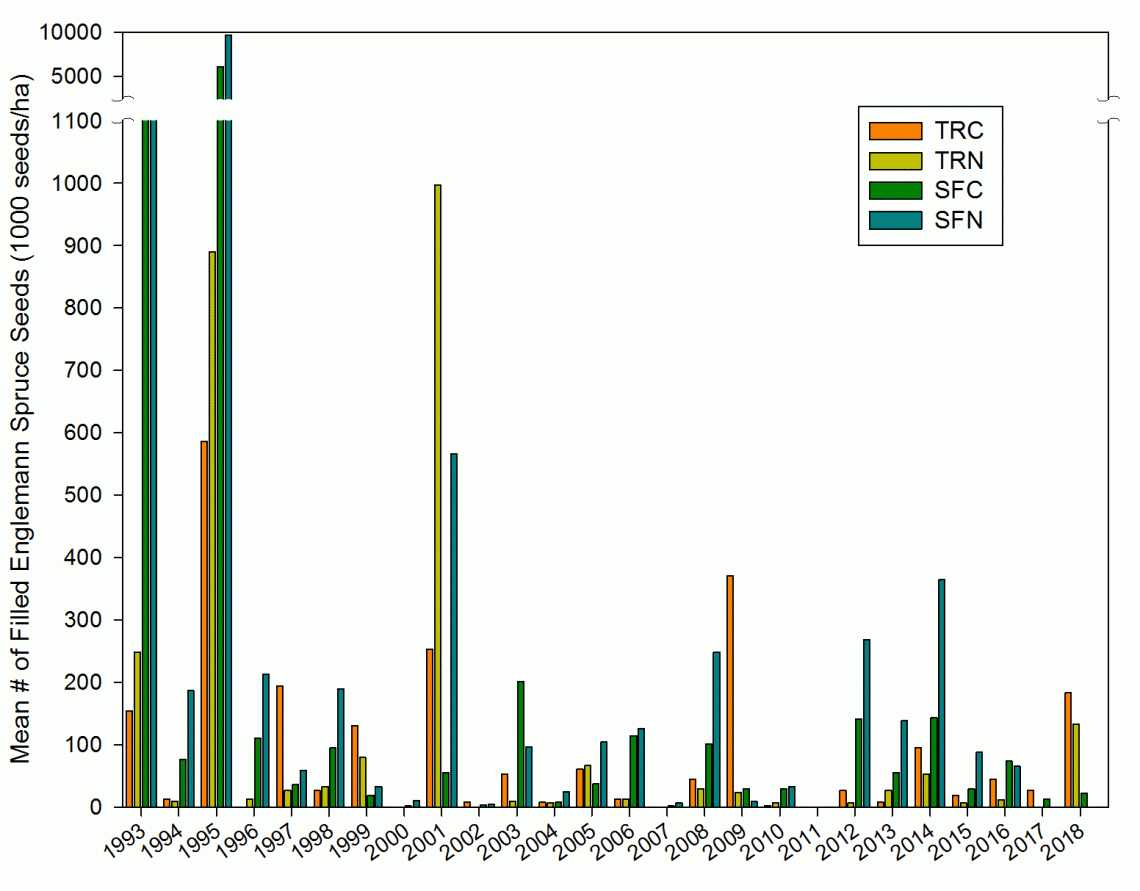
AR19DouglasFirSeeds.gif

AR19FCorkbarkFirSeeds.gif
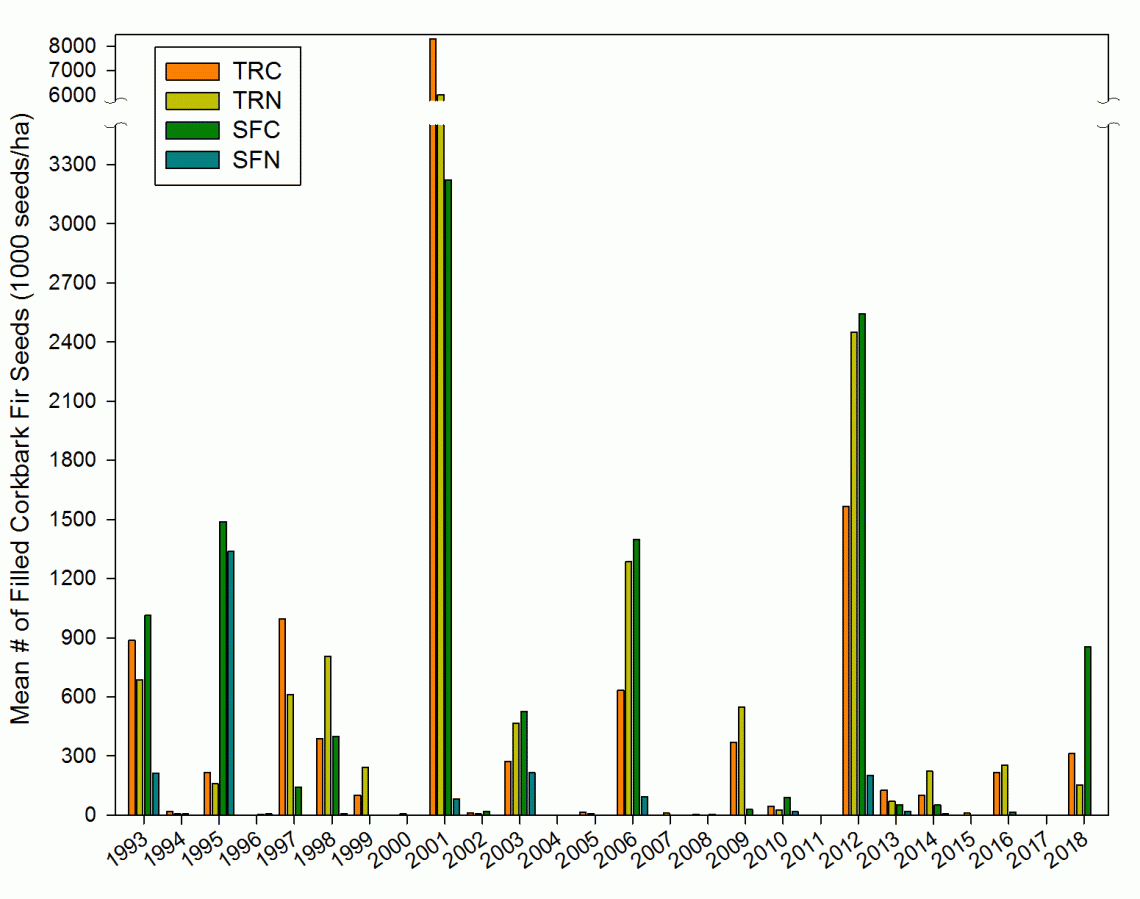
Mushrooms
Biomass measurements are used to compare mushroom productivity differences between habitats and between construction and non-construction areas, which helps define the food availability for Mount Graham red squirrel populations. All mushrooms found within established transects are plucked from the stalk base or fruiting base, weighed (to the nearest 0.1g), and identified to genus using diagnostic macroscopic and microscopic characteristics. The mean annual mushroom production is extrapolated from the transect data as Kg wet weight/ha.
*Note there was no mushroom production in our study areas in 2017 following the Frye Fire
AR19Mushrooms.gif
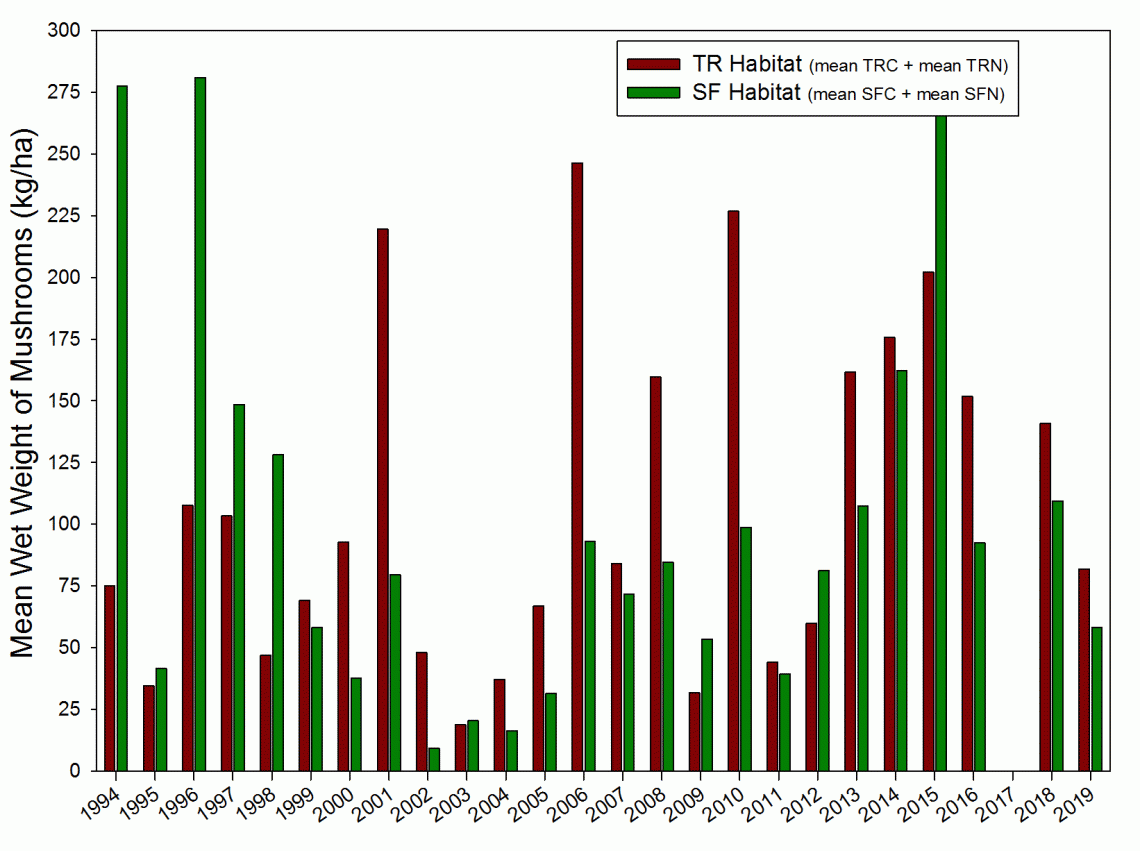
Annual Reports
| Year | Link |
|---|---|
|
1990 |
|
| 1991 | |
| 1992 | |
| 1993 | coming soon |
| 1994 | coming soon |
| 1995 | coming soon |
| 1996 | |
| 1997 | |
| 1998 | |
| 1999 | |
| 2000 | |
| 2001 | |
| 2002 | |
| 2003 | |
| 2004 | |
| 2005 | |
| 2006 | |
| 2007 | |
| 2008 | |
| 2009 | |
| 2010 | |
| 2011 | |
| 2012 | |
| 2013 | |
| 2014 | |
| 2015 | |
| 2016 | |
| 2017 | |
| 2018 | |
| 2019 |



